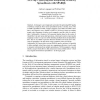117 search results - page 16 / 24 » Multiple sequence alignment using partial order graphs |
BMCBI
2006
13 years 7 months ago
2006
Background: Protein sequence clustering has been widely used as a part of the analysis of protein structure and function. In most cases single linkage or graph-based clustering al...
BMCBI
2006
13 years 7 months ago
2006
Background: Phylogenetic analyses of protein families are used to define the evolutionary relationships between homologous proteins. The interpretation of protein-sequence phyloge...
ICDM
2007
IEEE
14 years 1 months ago
2007
IEEE
We consider the problem of elastic matching of sequences of real numbers. Since both a query and a target sequence may be noisy, i.e., contain some outlier elements, it is desirab...
SEMWEB
2009
Springer
14 years 2 months ago
2009
Springer
In this paper a novel approach is presented for generating RDF graphs of arbitrary complexity from various spreadsheet layouts. Currently, none of the available spreadsheet-to-RDF ...
NETWORKS
2011
12 years 10 months ago
2011
A graph is terminal ∆ − Y -reducible if, it can be reduced to a distinguished set of terminal vertices by a sequence of series-parallel reductions and ∆−Y -transformations...



